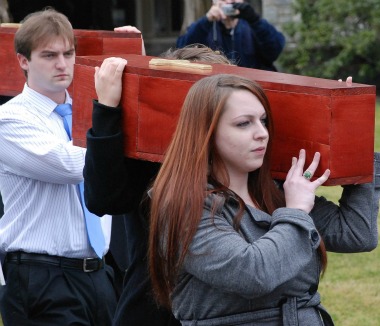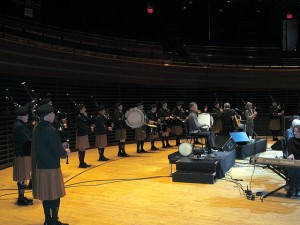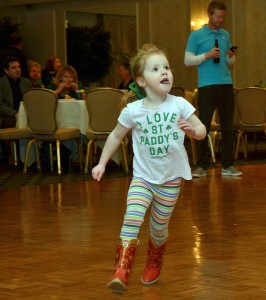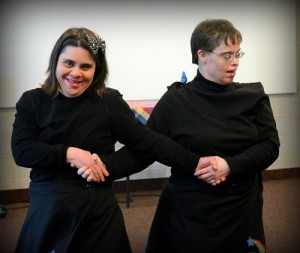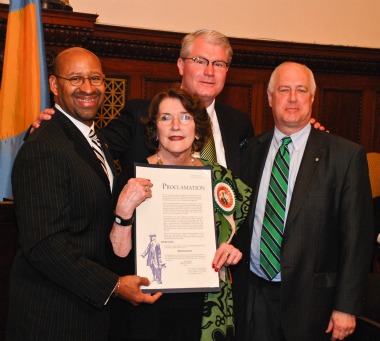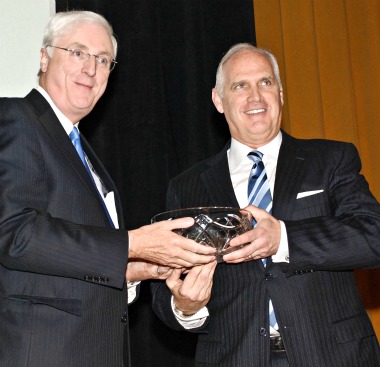They were buried for 180 years, but on Friday, March 9, five Irish immigrants were finally laid to rest at the West Laurel Hill Cemetery in Bala Cynwyd. When they died—or were killed—along the stretch of the rail line known as Duffy’s Cut in Malvern, they and 52 of their co-workers were unceremoniously dumped into a mass grave that wasn’t discovered until 2005.
This time, their caskets, hewn of pine, were carried reverently by some of the Immaculata University students who participated in the archeological dig that unearthed them and their stories after nearly two centuries. An honor guard from the Philadelphia Donegal Society and the 69th Irish Brigade re-enactors followed them. And the men who found them—Dr. William Watson, head of Immaculata’s history department and his twin brother, the Rev. Frank Watson, a Lutheran minister—brought their small seven-person pipe and drum corps to pipe them home.
The five, four men and a woman, likely a washerwoman who tended the workers, were laid to rest under a 10-foot tall Celtic cross carved in County Waterford, Ireland and finished in New Jersey. The foundation stone on which it sits contains the story of Duffy’s Cut as well as a carving of the John Stamp, the ship that carried them from Derry, and the names of all 57 immigrants and their homelands taken from the ship’s manifest.
Irish tenor, Tommy McCloskey, sang both the Irish and American national anthems, as well as “Danny Boy,” a song often thought to be a ballad for a young man either going off to war or lost to emigration.
Kevin Conmy, deputy chief of mission at the Irish Embassy in Washington stood in for Ambassador Michael Collins, who had been expected to attend but who had to return to Ireland after the death of his mother. The prayer service was conducted jointly by Rev. Watson, and Archdiocesan Auxiliary Bishop Michael Fitzgerald.
Rev. Watson to the crowd of nearly 200 who gathered for the service that the Duffy’s Cut immigrants were victims of both “cholera and violence.”
Eight weeks after sailing to find work in the US in 1832, all 57 immigrants from Donegal, Tyrone and Derry, were dead, some from cholera, a bacterial infection spread through contaminated water or food, and the others, according to forensic analysis, by murder. The Watsons believe that they were killed by local vigilantes—possibly the East Whiteland Horse Company—who feared they would spread the disease to others in the community and who were likely also prejudiced against both the Irish and Catholics.
Janet Monge, an anthropologist who worked on the project, found signs of violence. One skull had what appeared to be a bullet hole. Others had signs of blunt force trauma, including what looked to be the blow of an ax or pick.
“It was anti-Catholic, anti-Irish prejudice, white on white racism,” said Dr. Bill Watson who, like his brother, was dressed in a ceremonial kilt.
Ghost stories and efforts by the Irish railroad community kept the immigrants’ memories alive for a time. But the story had faded like an old photograph by the time the Watsons came across some papers left behind by their late grandfather, an assistant to the president of the Pennsylvania railroad, that showed that the railroad had covered up the deaths.
The dig, which started in 2005, first found old glass buttons, shards of crockery, and clay pipes, including one stamped with an Irish harp and the words “Erin go Bragh,” or Ireland forever. Then, in 2009, the first body was discovered after the Watsons brought in a geologist with radar. It is also the only set of remains to be identified.
John Ruddy was only 18 when he sailed to the US from Derry in June 1832. He was identified initially from a missing upper right first molar, a rare genetic defect that affects other Ruddy family members in the Inishowen region of Donegal. One, Liam Ruddy, flew to the US to give a DNA sample. He himself has no upper right molar and neither do two of his aunts. There is even a family story of a young Ruddy who emigrated to the US and was never heard from again.
Ruddy’s body will eventually be buried in Donegal.
The Watsons had intended to remove all the remains, but most of them—likely the cholera victims–are buried deep near and under tracks still in use which may make that difficult if not impossible. Immaculata is establishing an institute to investigate other mass graves in Pennsylvania. The Watsons are also looking into the possibility that Phillip Duffy, the contractor who brought the immigrants over to work on the railroad, may be buried in St. Anne’s Parish cemetery on Lehigh Street in Philadelphia.
St. Anne’s pastor, the Rev. Edward Brady, attended the Duffy’s Cut ceremony. “We think Duffy, his wife, and either son or daughter are buried there, but there’s no tombstone,” said Father Brady, who serves as chaplain to the Irish Memorial, a monument to Irish immigrants that overlooks the Delaware River at Penns Landing in Philadelphia. “We’re going to have to verify it with funeral records. We’re looking into it.”
View our photos of the Duffy’s Cut funeral services.

